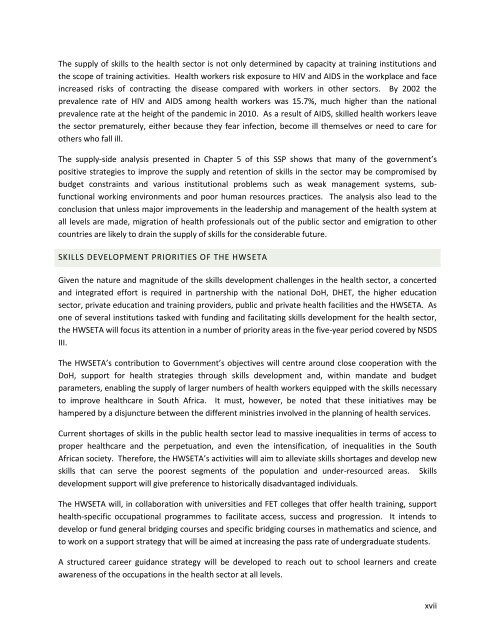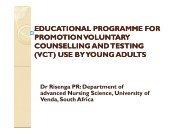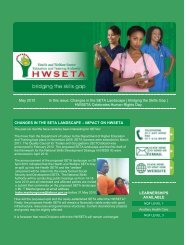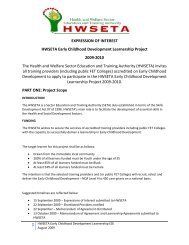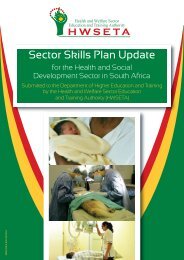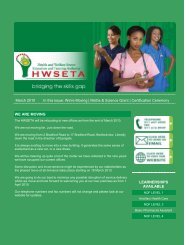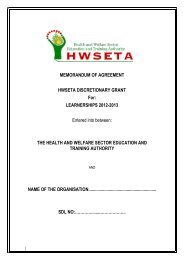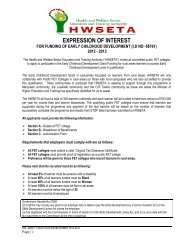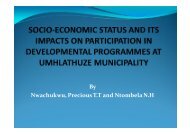sector skills plan for the health sector in south africa
sector skills plan for the health sector in south africa
sector skills plan for the health sector in south africa
Create successful ePaper yourself
Turn your PDF publications into a flip-book with our unique Google optimized e-Paper software.
The supply of <strong>skills</strong> to <strong>the</strong> <strong>health</strong> <strong>sector</strong> is not only determ<strong>in</strong>ed by capacity at tra<strong>in</strong><strong>in</strong>g <strong>in</strong>stitutions and<br />
<strong>the</strong> scope of tra<strong>in</strong><strong>in</strong>g activities. Health workers risk exposure to HIV and AIDS <strong>in</strong> <strong>the</strong> workplace and face<br />
<strong>in</strong>creased risks of contract<strong>in</strong>g <strong>the</strong> disease compared with workers <strong>in</strong> o<strong>the</strong>r <strong>sector</strong>s. By 2002 <strong>the</strong><br />
prevalence rate of HIV and AIDS among <strong>health</strong> workers was 15.7%, much higher than <strong>the</strong> national<br />
prevalence rate at <strong>the</strong> height of <strong>the</strong> pandemic <strong>in</strong> 2010. As a result of AIDS, skilled <strong>health</strong> workers leave<br />
<strong>the</strong> <strong>sector</strong> prematurely, ei<strong>the</strong>r because <strong>the</strong>y fear <strong>in</strong>fection, become ill <strong>the</strong>mselves or need to care <strong>for</strong><br />
o<strong>the</strong>rs who fall ill.<br />
The supply-side analysis presented <strong>in</strong> Chapter 5 of this SSP shows that many of <strong>the</strong> government’s<br />
positive strategies to improve <strong>the</strong> supply and retention of <strong>skills</strong> <strong>in</strong> <strong>the</strong> <strong>sector</strong> may be compromised by<br />
budget constra<strong>in</strong>ts and various <strong>in</strong>stitutional problems such as weak management systems, subfunctional<br />
work<strong>in</strong>g environments and poor human resources practices. The analysis also lead to <strong>the</strong><br />
conclusion that unless major improvements <strong>in</strong> <strong>the</strong> leadership and management of <strong>the</strong> <strong>health</strong> system at<br />
all levels are made, migration of <strong>health</strong> professionals out of <strong>the</strong> public <strong>sector</strong> and emigration to o<strong>the</strong>r<br />
countries are likely to dra<strong>in</strong> <strong>the</strong> supply of <strong>skills</strong> <strong>for</strong> <strong>the</strong> considerable future.<br />
SKILLS DEVELOPMENT PRIORITIES OF THE HWSETA<br />
Given <strong>the</strong> nature and magnitude of <strong>the</strong> <strong>skills</strong> development challenges <strong>in</strong> <strong>the</strong> <strong>health</strong> <strong>sector</strong>, a concerted<br />
and <strong>in</strong>tegrated ef<strong>for</strong>t is required <strong>in</strong> partnership with <strong>the</strong> national DoH, DHET, <strong>the</strong> higher education<br />
<strong>sector</strong>, private education and tra<strong>in</strong><strong>in</strong>g providers, public and private <strong>health</strong> facilities and <strong>the</strong> HWSETA. As<br />
one of several <strong>in</strong>stitutions tasked with fund<strong>in</strong>g and facilitat<strong>in</strong>g <strong>skills</strong> development <strong>for</strong> <strong>the</strong> <strong>health</strong> <strong>sector</strong>,<br />
<strong>the</strong> HWSETA will focus its attention <strong>in</strong> a number of priority areas <strong>in</strong> <strong>the</strong> five-year period covered by NSDS<br />
III.<br />
The HWSETA’s contribution to Government’s objectives will centre around close cooperation with <strong>the</strong><br />
DoH, support <strong>for</strong> <strong>health</strong> strategies through <strong>skills</strong> development and, with<strong>in</strong> mandate and budget<br />
parameters, enabl<strong>in</strong>g <strong>the</strong> supply of larger numbers of <strong>health</strong> workers equipped with <strong>the</strong> <strong>skills</strong> necessary<br />
to improve <strong>health</strong>care <strong>in</strong> South Africa. It must, however, be noted that <strong>the</strong>se <strong>in</strong>itiatives may be<br />
hampered by a disjuncture between <strong>the</strong> different m<strong>in</strong>istries <strong>in</strong>volved <strong>in</strong> <strong>the</strong> <strong>plan</strong>n<strong>in</strong>g of <strong>health</strong> services.<br />
Current shortages of <strong>skills</strong> <strong>in</strong> <strong>the</strong> public <strong>health</strong> <strong>sector</strong> lead to massive <strong>in</strong>equalities <strong>in</strong> terms of access to<br />
proper <strong>health</strong>care and <strong>the</strong> perpetuation, and even <strong>the</strong> <strong>in</strong>tensification, of <strong>in</strong>equalities <strong>in</strong> <strong>the</strong> South<br />
African society. There<strong>for</strong>e, <strong>the</strong> HWSETA’s activities will aim to alleviate <strong>skills</strong> shortages and develop new<br />
<strong>skills</strong> that can serve <strong>the</strong> poorest segments of <strong>the</strong> population and under-resourced areas. Skills<br />
development support will give preference to historically disadvantaged <strong>in</strong>dividuals.<br />
The HWSETA will, <strong>in</strong> collaboration with universities and FET colleges that offer <strong>health</strong> tra<strong>in</strong><strong>in</strong>g, support<br />
<strong>health</strong>-specific occupational programmes to facilitate access, success and progression. It <strong>in</strong>tends to<br />
develop or fund general bridg<strong>in</strong>g courses and specific bridg<strong>in</strong>g courses <strong>in</strong> ma<strong>the</strong>matics and science, and<br />
to work on a support strategy that will be aimed at <strong>in</strong>creas<strong>in</strong>g <strong>the</strong> pass rate of undergraduate students.<br />
A structured career guidance strategy will be developed to reach out to school learners and create<br />
awareness of <strong>the</strong> occupations <strong>in</strong> <strong>the</strong> <strong>health</strong> <strong>sector</strong> at all levels.<br />
xvii


